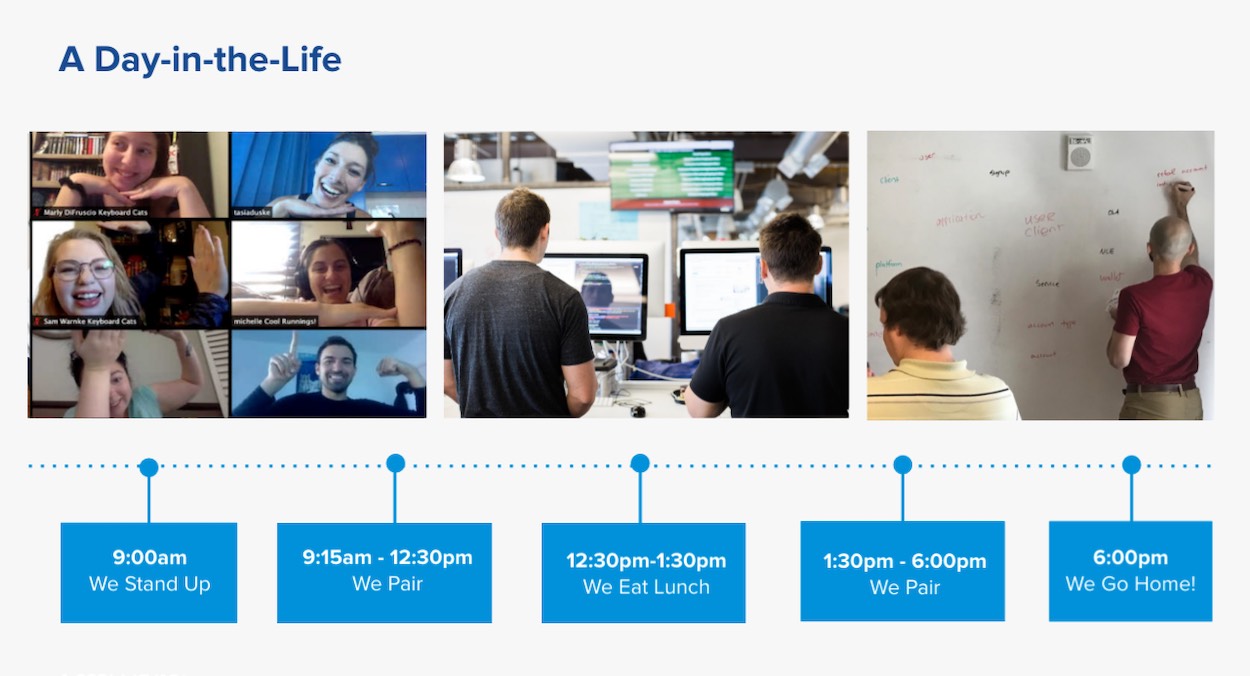Foundations of Modern Application Development Practices
Team Rhythm
Pivotal/Tanzu Labs
A healthy lean and agile team has a strong and consistent rhythm. Each week is punctuated by a small set of standing practices and meetings.
It is critical to establish a psychologically safe work environment. Many of the following practices emphasize asking for help, volunteering to help others, explaining your reasoning, challenging the reasoning of others, and laying bare what you feel is and is not working well on the project. This will not happen within a toxic work environment where honesty and vulnerability are punished, mocked, or reduce one’s standing in the organization.

What you will learn
In this article, you will learn to:
- List the daily meetings and describe your role in each one.
- List the weekly meetings and describe your role in each one.
List daily meetings and describe your role in each one
Too many meetings can be a time-sink, especially daily meetings. We recommend the following high-value meetings, and to limit them to about 15 minutes.

Office, department, or cross-team stand-up
Your team’s interesting discoveries might unblock other teams. The problem that is stumping you might have recently been solved by another team. Office, department, or other cross-team stand-up meetings are an efficient way to share information quickly.
These gatherings do not have to only be about work. Office, department, and other cross-team stand-ups are an opportunity to build personal relationships by sharing social events, local happenings, or even trivia.
We commonly see daily stand-up meetings having four categories: new faces, help requests, interesting things, and events.
Your role as a Participant when the stand-up moderator announces each topic:
- Announce new teammates or guests.
- Ask for help if you or your team need it.
- Share interesting or notable things you’ve learned that could help other teams.
- Announce and/or volunteer to participate in events.
Project Stand-up
The main purpose of the project stand-up is to check in on everyone’s progress, plan, and blockers. Another subtle but powerful purpose is to align everyone’s schedules, almost like synchronizing everyone’s clock.
Some teams prefer to have everyone (or each pair) report on what they did the previous day. Other teams omit the status report and adopt a format similar to the office, department, or cross-team stand-up, choosing to discuss blockers and other topics impacting the project. Experiment with both formats.
Tip: Each week, have a different team member volunteer to facilitate the daily project stand-up. This reduces facilitation fatigue.
Your role as a Team Member:
- Report on the previous workday’s progress as needed.
- Report any interesting or project-impacting topics.
- Understand blockers and their implications on the current priorities.
- Remind everyone of outstanding team action items and upcoming milestones.
List the weekly meetings and describe your role in each one
Iteration Planning Meeting
The Iteration Planning Meeting (IPM) is a regular meeting for the core team to understand and align on the work to be done. It is similar but different to SCRUM Sprint Planning,
Regular planning meetings help ensure the product backlog is well-understood by all team members and always reflects the current priorities. By discussing and sizing product backlog items, the team may align on the delivery impact of the work to be done.
Your role as a Developer:
- Consider the technical feasibility of the user stories and raise any concerns.
- Look for and suggest opportunities to break down large stories into smaller stories.
- Ensure user stories describe the desired outcomes, and not the technical implementation.
- Estimate stories.
Your role as a Product Manager:
- Communicate the user value and business value of each story.
- Clarify any confusion and update stories.
- Confirm the priority of stories with input from the developers.
Your role as a Product Designer:
- Illustrate the user value associated with each story with supporting artifacts (prototypes, flow diagrams, personas, etc.)
- Frame the supporting evidence (user research, testing results, etc.) for certain user flows
- Clarify and walk through interaction patterns for certain user flows so it’s clear to the entire balanced team
To learn more about IPMs and how to facilitate them, go here.
Sponsor/Stakeholder Update and Demo
It is extremely important to keep the product sponsors and stakeholders informed regarding the team’s progress. This helps avoid miscommunication and other forms of misalignment, especially if stakeholder-level priorities have changed.
We recommend covering the following topics during these updates:
- Demo the current state of the product, especially new or changed functionality.
- Discuss learnings from customers.
- Raise awareness of blocking issues preventing the team from making progress.
- Share updates on Key Performance Indicators (KPIs).
- Share what the team plans to work on next.
Your role as a Product Manager:
- Prepare the agenda with your anchor and designer.
- Use your product roadmap to explain what the team is working on and why.
- Frame the demo in the context of the outcomes defined in the product roadmap.
- Speak to the empirical data guiding the team’s decisions.
- Speak to your assumptions, both those you have tested, and those you plan to test.
- If blocked, explain what the team needs, why, and by when.
Your role as a Team Member:
- Listen, participate, take notes, and answer questions.
Retrospective

Some feel that the Retrospective practice is the most important of all Agile practices as it embodies the principle of continuous improvement. Retrospectives are a way to identify how to improve teamwork by reflecting on what worked well, what could be improved, and what is on people’s minds.
Continuous reflection on how the team and project are performing allow us to learn and improve based on our past experience, constantly striving for better outcomes and to correct misalignment.
Teams typically host “the retro” on a weekly basis to celebrate the past week’s successes, discuss points of confusion, and reflect on challenges.
Your role as a Meeting Participant:
- Openly and honestly share your experiences from the week.
- Dig deeper on topics raised by others to understand root causes.
- Identify action items to address issues raised.
- Sign up for action items and be accountable for their completion.
To learn more about Retrospectives and how to facilitate them, go here.
In this article, you learned to:
- List the daily meetings and your role in each one.
- List the weekly meetings and your role in each one.
Keep Learning
- Agile Estimating and Planning by Mike Cohn
- Yesterday’s Weather
- Planning Poker
- Chapter 12 of Extreme Programming Explained by Kent Beck, Cynthia Andres
- ExtremeProgramming.org
- Agile Retrospectives - Making Good Teams Great by Esther Derby and Diana Larsen, Foreword by Ken Schwaber
- How to Run a Really Good Retrospective - Blog Post by Nicola Rushton
- Measure Success in Agile Retrospectives – Video by Enrico Teotti